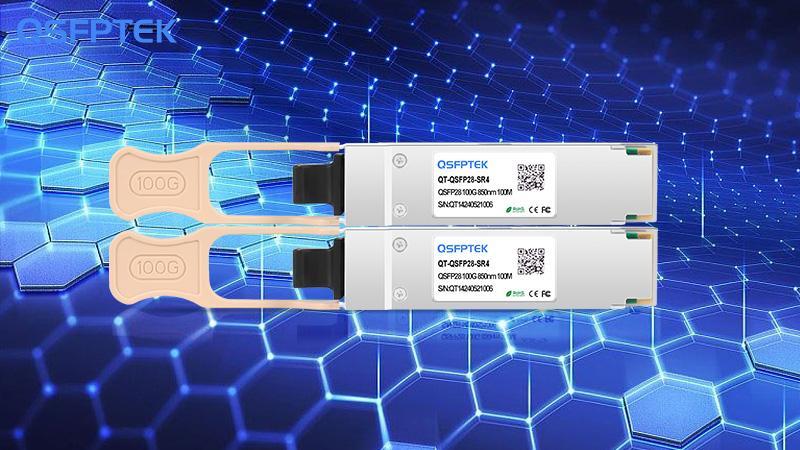Introduction: Choosing the Right Optical Module for Your Network
In today’s high-speed networking world, selecting the right optical module is crucial for ensuring efficient data transmission. Among the most commonly used modules in modern data centers and enterprise networks are the 100GBASE-SR4 and 100GBASE-LR4 optical modules. While both modules serve the same general purpose—enabling 100 Gbps data transfer—they differ significantly in their design and use cases. Understanding these differences is key to making the right choice for your network’s performance and cost-efficiency.
Understanding 100GBASE-SR4
The 100GBASE-SR4 optical module is a short-range transceiver designed for high-speed, data-intensive environments, typically within a data center. This module operates on multimode fiber (MMF) and provides a transmission distance of up to 100 meters at 100 Gbps, making it ideal for short-range connections. The SR4 module utilizes four parallel lanes, each capable of transmitting at 25 Gbps, for a total of 100 Gbps. This parallel transmission method helps to achieve the high-speed data rates while keeping the cost of the module relatively low.
One of the key advantages of 100GBASE-SR4 is its cost-effectiveness. Due to its short-range capabilities, it’s typically used in environments where long-distance transmission is not required, such as within a single data center or campus network. The SR4 is well-suited for use with MTP/MPO connectors, offering high-density configurations and simplifying installation. However, its range limitations mean it’s not suitable for connections that span long distances or require high levels of reliability over vast geographic areas.
Understanding 100GBASE-LR4
In contrast, the 100GBASE-LR4 is a long-range optical module that is built for applications requiring high performance over long distances. Unlike the SR4, the LR4 operates on single-mode fiber (SMF) and supports transmission distances up to 10 kilometers at 100 Gbps, making it ideal for wide-area networks (WANs), metropolitan area networks (MANs), or inter-campus connections. The LR4 achieves this longer range by using four independent channels, each transmitting at 25 Gbps, but through the use of different wavelength division multiplexing (WDM) technology to increase efficiency and range.
One of the main advantages of the 100GBASE-LR4 is its reliability over long distances. This module is designed for higher signal integrity and lower loss across the network, making it the preferred choice for telecom providers and enterprises that need to establish reliable connections over greater distances. Its ability to maintain high-quality signal transmission over up to 10 kilometers is a significant advantage, but it does come at a higher price point compared to the SR4. Additionally, its use of single-mode fiber allows for lower attenuation and better performance in the long haul.
Comparing 100GBASE-SR4 and 100GBASE-LR4
While both the 100GBASE-SR4 and 100GBASE-LR4 modules deliver 100 Gbps data rates, the main difference lies in their transmission distances and fiber types. The SR4 is ideal for short-range, high-density environments such as data centers, where cost-efficiency is paramount. It performs well in networks where data only needs to travel across relatively short distances—often just within a building or between nearby locations. On the other hand, the LR4 is designed for long-range applications, delivering 100 Gbps over distances of up to 10 kilometers. Its use of single-mode fiber and wavelength division multiplexing ensures reliable performance over these greater distances, making it the better choice for wide-area network (WAN) and metro network connections.
Beyond just the transmission distance, these two modules also differ in their power consumption and price. Generally, the SR4 is less power-hungry than the LR4, which is a consideration for data centers trying to minimize energy costs. The LR4, due to its advanced technology and long-range capabilities, is typically more expensive and may require additional infrastructure like high-performance optical amplifiers to ensure consistent signal quality over long distances.
Conclusion: Selecting the Right Module for Your Needs
Choosing between 100GBASE-SR4 and 100GBASE-LR4 depends largely on your specific network requirements. If you’re building or upgrading a data center and need cost-effective, high-speed connections over relatively short distances, the 100GBASE-SR4 is an excellent choice. Its affordability, combined with the convenience of multimode fiber, makes it a popular option for short-range deployments.
However, if your network needs to support long-distance connections, such as across cities or between data centers, the 100GBASE-LR4 is the better option. Although it comes with a higher cost, its performance over longer distances and its ability to maintain signal integrity over 10 kilometers makes it invaluable for wide-area network applications.
Both modules have their place in high-speed networks, and understanding their strengths and limitations will help you make an informed decision.





